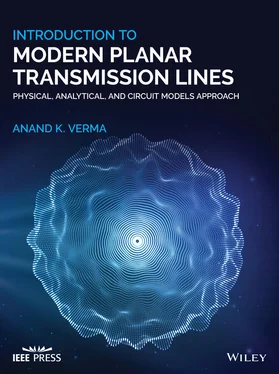1 Cover
2 Title Page
3 Copyright Page
4 Dedication Page
5 Preface
6 Acknowledgments
7 Author Biography
8 1 Overview of Transmission LinesIntroduction 1.1 Overview of the Classical Transmission Lines 1.2 Planar Transmission Lines 1.3 Overview of Present Book References
9 2 Waves on Transmission Lines – IIntroduction 2.1 Uniform Transmission Lines 2.2 Multisection Transmission Lines and Source Excitation 2.3 Nonuniform Transmission Lines References
10 3 Waves on Transmission Lines – IIIntroduction 3.1 Matrix Description of Microwave Network 3.2 Conversion and Extraction of Parameters 3.3 Wave Velocity on Transmission Line 3.4 Linear Dispersive Transmission Lines References
11 4 Waves in Material Medium – IIntroduction 4.1 Basic Electrical Quantities and Parameters 4.2 Electrical Property of Medium 4.3 Circuit Model of Medium 4.4 Maxwell Equations and Power Relation 4.5 EM‐waves in Unbounded Isotropic Medium 4.6 Polarization of EM‐waves 4.7 EM‐waves Propagation in Unbounded Anisotropic Medium References
12 5 Waves in Material Medium‐IIIntroduction 5.1 EM‐Waves at Interface of Two Different Media 5.2 Oblique Incidence of Plane Waves 5.3 Special Cases of Angle of Incidence 5.4 EM‐Waves Incident at Dielectric Slab 5.5 EM‐Waves in Metamaterials Medium References
13 6 Electrical Properties of Dielectric MediumIntroduction 6.1 Modeling of Dielectric‐Medium 6.2 Static Dielectric Constants of Materials 6.3 Dielectric Mixtures 6.4 Frequency Response of Dielectric Materials 6.5 Resonance Response of the Dielectric‐Medium 6.6 Interfacial Polarization 6.7 Circuit Models of Dielectric Materials 6.8 Substrate Materials for Microwave Planar Technology References
14 7 Waves in Waveguide MediumIntroduction 7.1 Classification of EM‐Fields 7.2 Boundary Surface and Boundary Conditions 7.3 TEM‐Mode Parallel‐Plate Waveguide 7.4 Rectangular Waveguides 7.5 Conductor Backed Dielectric Sheet Surface Wave Waveguide 7.6 Equivalent Circuit Model of Waveguide 7.7 Transverse Resonance Method (TRM) 7.8 Substrate Integrated Waveguide (SIW) References
15 8 Microstrip LineIntroduction 8.1 General Description 8.2 Static Closed‐Form Models of Microstrip Line 8.3 Dispersion in Microstrip Line 8.4 Losses in Microstrip Line 8.5 Circuit Model of Lossy Microstrip Line References
16 9 Coplanar Waveguide and Coplanar StriplineIntroduction 9.1 General Description 9.2 Fundamentals of Conformal Mapping Method 9.3 Conformal Mapping Analysis of Coplanar Waveguide 9.4 Coplanar Stripline 9.5 Effect of Conductor Thickness on Characteristics of CPW and CPS Structures 9.6 Modal Field and Dispersion of CPW and CPS Structures 9.7 Losses in CPW and CPS Structures 9.8 Circuit Models and Synthesis of CPW and CPS References
17 10 Slot LineIntroduction 10.1 Slot Line Structures 10.2 Analysis and Modeling of Slot Line 10.3 Waveguide Model 10.4 Closed‐form Models References Journals Appendix – I Appendix – II
18 11 Coupled Transmission LinesIntroduction 11.1 Some Coupled Line Structures 11.2 Basic Concepts of Coupled Transmission Lines 11.3 Circuit Models of Coupling 11.4 Even–Odd Mode Analysis of Symmetrical Coupled Lines 11.5 Wave Equation for Coupled Transmission Lines References
19 12 Planar Coupled Transmission LinesIntroduction 12.1 Line Parameters of Symmetric Edge Coupled Microstrips 12.2 Line Parameters of Asymmetric Coupled Microstrips 12.3 Line Parameters of Coupled CPW 12.4 Network Parameters of Coupled Line Section 12.5 Asymmetrical Coupled Lines Network Parameters References
20 13 Fabrication of Planar Transmission LinesIntroduction 13.1 Elements of Hybrid MIC (HMIC) Technology 13.2 Elements of Monolithic MIC (MMIC) Technology 13.3 Micromachined Transmission Line Technology 13.4 Elements of LTCC References
21 14 Static Variational Methods for Planar Transmission LinesIntroduction 14.1 Variational Formulation of Transmission Line 14.2 Variational Expression of Line Capacitance in Fourier Domain 14.3 Analysis of Microstrip Line by Variational Method 14.4 Analysis of Multilayer Microstrip Line 14.5 Analysis of Coupled Microstrip Line in Multilayer Dielectric Medium 14.6 Discrete Fourier Transform Method References
22 15 Multilayer Planar Transmission LinesIntroduction 15.1 SLR Process for Multilayer Microstrip Lines 15.2 SLR Process for Multilayer Coupled Microstrip Lines 15.3 SLR Process for Multilayer ACPW/CPW 15.4 Further Consideration of SLR Formulation References
23 16 Dynamic Spectral Domain AnalysisIntroduction 16.1 General Discussion of SDA 16.2 Green's Function of Single‐Layer Planar Line 16.3 Solution of Hybrid Mode Field Equations (Galerkin's Method in Fourier Domain) 16.4 Basis Functions for Surface Current Density and Slot Field 16.5 Coplanar Multistrip Structure 16.6 Multilayer Planar Transmission Lines References
24 17 Lumped and Line ResonatorsIntroduction 17.1 Basic Resonating Structures 17.2 Zero‐Dimensional Lumped Resonator 17.3 Transmission Line Resonator References
25 18 Planar Resonating StructuresIntroduction 18.1 Microstrip Line Resonator 18.2 CPW Resonator 18.3 Slot Line Resonator 18.4 Coupling of Line Resonator to Source and Load 18.5 Coupled Resonators 18.6 Microstrip Patch Resonators 18.7 2D Fractal Resonators 18.8 Dual‐Mode Resonators References
26 19 Planar Periodic Transmission LinesIntroduction 19.1 1D and 2D Lattice Structures 19.2 Space Harmonics of Periodic Structures 19.3 Circuit Models of 1D Periodic Transmission Line 19.4 1D Planar EBG Structures References
27 20 Planar Periodic SurfacesIntroduction 20.1 2D Planar EBG Surfaces 20.2 Circuit Models of Mushroom‐Type EBG 20.3 Uniplanar EBG Structures 20.4 2D Circuit Models of EBG Structures References
28 21 Metamaterials Realization and Circuit Models – IIntroduction 21.1 Artificial Electric Medium 21.2 Artificial Magnetic Medium 21.3 Double Negative Metamaterials 21.4 Homogenization and Parameters Extraction References
29 22 Metamaterials Realization and Circuit Models – IIIntroduction 22.1 Circuit Models of 1D‐Metamaterials 22.2 Nonresonant Microstrip Metalines 22.3 Resonant Metalines 22.4 Some Applications of Metalines 22.5 Modeling and Characterization of Metsurfaces 22.6 Applications of Metasurfaces References
30 Index
31 End User License Agreement
1 Chapter 8Table 8.1a Comparison of computed ε reff(f = 0) by several numerical methods a...Table 8.1b The ε reff(f = 0) and characteristic impedance of microstrip lines....Table 8.2 Comparison of computed ε reff(f = 0) of the shielded microstrip by n...Table 8.3 Normalized dielectric loss of microstrip line in dB/λ g.
2 Chapter 9Table 9.1 Conformal transformation using t = Sn(z,k) mapping function.Table 9.2 Transformation using t = sinh(πz/2h) .Table 9.3 Transformation using t = z 2.Table 9.4 Transformation using x = cosh 2(π z/2h).Table 9.5 Transformation using x = cosh 2(πz/2h 1) .Table 9.6 Transformation using t = cosh 2[πz/2h].Table 9.7 Transformation using t = sinh(πz/2h).Table 9.8 The values for the coefficient α 1− α 9.
3 Chapter 11Table 11.1 Designation of the ports of a 4‐port coupler.
4 Chapter 13Table 13.1 Some commonly used plastic, ceramic, and semiconducting substrates...Table 13.2 Some commonly used semiconducting substrates.
5 Chapter 14Table 14.1 Comparison of the computed value of Z 0of microstrip against exper...Table 14.2 Equivalence of variables.Table 14.3 Comparison of results of ε reffe(0) and ε reffo(0) for the coupled m...
6 Chapter 15Table 15.1 % Average deviation in CPW dynamic line parameters computed by the...
7 Chapter 18Table 18.1 Resonance frequency compression of fractal planar resonators.Table 18.2 Simulation results of two configurations of microstrip Hilbert lin...
Читать дальше












